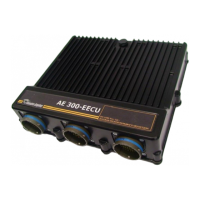Document No.: E4.08.09 E4.08.09 : AE_xx_000
Revision: 13 9 : 00
Page: 57 of 89
Copyright © 2019, Austro Engine GmbH
Dept.: Electric/Electronic
Example 2 (normal take-off):
Time line from left to right:
- Lead-in: At 20.4.2009 13:58:53 (UTC), means ECU-A was powered up and initialized at
that time (engine master ON), the data logger writes the lead in to mark the beginning
of this flight cycle
- Barometric air pressure: Starts around 980 hPa (= pressure altitude at LOAN) aircraft is
on the ground and after takeoff steadily climbing through 963 hPa (~ 1400 ft. in ISA
standard atmosphere) at 14:04:29 UTC
- Engine oil temperature: Starts around 80 °C, indicating a warm start and climbs through
88.76 °C at 14:02:32 UTC to reach 3minutes later (time line 3270 - 3090 = 180 sec-
onds) about 105 °C
- Gearbox oil temperature: Roughly follows the engine oil temperature at a lower level
- Propeller speed: At time line 3380 – 3360 the propeller self-test takes place (indicated
by two distinctive 1900 rpm “humps” while the power lever is at idle (0%)
- Power lever position: After start up and taxi variations, the power lever remains at idle
(0%) during the propeller self-test (time line 3380 – 3320) and is then advanced to full
power for takeoff and initial climb for a duration of about 30 seconds, first power reduc-
tion occurs at 14:02:45 UTC
- Engine oil level: From about 50mm at startup during some fluctuations during the
ground run, the oil level settles to about 35mm during the climb
- Combined engine status: At time line 3370 the status changes to D4 hex (= 11010100
bin), this means the self-test switched from ECU-A to ECU-B. At 14:02:30 the engine
status 1C hex (= 00011100 bin) drops to 12 hex (= 00001100 bin) which means the
squat switch (bit #4, weight on wheels) has been released indicating that the aircraft
was airborne at that time (see appendix “12.2.1 Combined Engine Status” for details)

